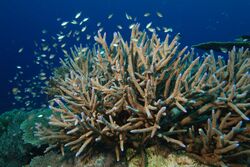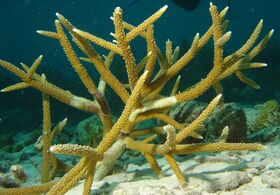Biology:Staghorn coral
| Staghorn coral | |
|---|---|

| |
| Scientific classification | |
| Domain: | Eukaryota |
| Kingdom: | Animalia |
| Phylum: | Cnidaria |
| Class: | Hexacorallia |
| Order: | Scleractinia |
| Family: | Acroporidae |
| Genus: | Acropora |
| Species: | A. cervicornis
|
| Binomial name | |
| Acropora cervicornis (Lamarck, 1816)[3]
| |
| Synonyms | |
|
List
| |
The staghorn coral (Acropora cervicornis) is a branching, stony coral with cylindrical branches ranging from a few centimetres to over two metres in length and height. It occurs in back reef and fore reef environments from 0 to 30 m (0 to 98 ft) depth. Wave forces dictate the upper threshold, while suspended sediments and the availability of light regulate the lower boundary. Until the mid-1980s, the intermediate depths of 5–25 meters (16–82 feet) in the fore reef zones were once primarily occupied by vast areas of staghorn coral, consisting largely of single-species stands. This coral exhibits the fastest growth of all known western Atlantic fringe corals, with branches increasing in length by 10–20 cm (3.9–7.9 in) per year. This has been one of the three most important Caribbean corals in terms of its contribution to reef growth and fishery habitat.
Distribution
Staghorn coral is found throughout the Florida Keys, the Bahamas, and the Caribbean islands. This coral occurs in the western Gulf of Mexico, but is absent from U.S. waters in the Gulf of Mexico, as well as Bermuda and the west coast of South America. The northern limit is on the east coast of Florida, around Jupiter, Florida.
Reproduction
The dominant mode of reproduction for staghorn corals is asexual, with new colonies forming when branches break off a colony and reattach to the substrate. This life history trait allows rapid population recovery from physical disturbances such as storms. However, it makes recovery from disease or bleaching episodes (where entire colonies or even entire stands are killed) very difficult.
Sexual reproduction is via broadcast spawning of gametes into the water column once each year in August or September. Individual colonies are both male and female (simultaneous hermaphrodites) and will release millions of gametes. The coral larvae (planula) live in the plankton for several days until finding a suitable area to settle; unfortunately, very few larvae survive to settle and metamorphose into new colonies.
Conservation
Threats and concerns

The preponderance of asexual reproduction in this species raises the possibility that genetic diversity in the remnant populations may be very low. These uncertainties as to recruitment/recovery potential and genetic status are the basis for conservation concerns for this species.
Between 1970 and 2020, the population of Acropora cervicornis in the Florida Keys has undergone a significant decline, surpassing 90%. This is caused by a combination of coral disease and bleaching as well as other stressors such as pollution and predation. In order to reduce the loss of this species, the Coral Restoration Foundation in conjunction with the NOAA Recovery Plan (NRP) started in 2007 outplanting coral projects to restore populations at sites in the Florida Keys National Marine Sanctuary where A. cerviconis was previously abundant.[4]
Endangered Species Act (ESA) listing history
On March 4, 2004, the Center for Biological Diversity petitioned the US National Marine Fisheries Service (NMFS) to list elkhorn (Acropora palmata), staghorn (A. cervicornis), and fused-staghorn (A. prolifera) coral under the ESA. On June 23, 2004, NOAA Fisheries found that listing these species may be warranted and initiated a formal review of their biological status. NMFS convened the Atlantic Acropora Biological Review Team to summarize the best available scientific and commercial data available for these species in the status review report.
The BRT finalized the status review on March 3, 2005. Subsequently, on March 18, 2005, the NMFS determined that both elkhorn and staghorn corals meet the criteria for being classified as "threatened" species under the ESA. However, NMFS also concluded that the fused-staghorn coral doesn't meet the criteria for listing, as it is identified as a hybrid and doesn't fall under the ESA's definition of a distinct species. On May 9, 2005, NMFS proposed the addition of elkhorn coral to the endangered species list.
NMFS designated critical habitat for elkhorn and staghorn corals in 2008.[5]
In December 2012, the National Marine Fisheries Service (NMFS) once more suggested reclassifying (77 FR 73219) the elkhorn and staghorn corals as endangered. However, by September 2014, they determined that both corals would continue to be listed as threatened (79 FR 53852).
Gallery
-
Staghorn coral alive at Looe Key, Florida Keys, July 2010
-
Endangered Staghorn Coral photographed off Haulover Bay, Saint John, US Virgin Islands, June 2013.
References
- ↑ Richards, Z.T.; Miller, D.J.; Wallace, C.C. (2013). "Molecular phylogenetics of geographically restricted Acropora species: Implications for threatened species conservation". Molecular Phylogenetics and Evolution (Elsevier BV) 69 (3): 837–851. doi:10.1016/j.ympev.2013.06.020. ISSN 1055-7903. PMID 23850500.
- ↑ Aronson, R.; Bruckner, A.; Moore, J.; Precht, B.; E. Weil (2008). "Acropora cervicornis". IUCN Red List of Threatened Species 2008: e.T133381A3716457. doi:10.2305/IUCN.UK.2008.RLTS.T133381A3716457.en. https://www.iucnredlist.org/species/133381/3716457. Retrieved 11 November 2022.
- ↑ WoRMS (2010). "Acropora cervicornis (Lamarck, 1816)". WoRMS. World Register of Marine Species. http://www.marinespecies.org/aphia.php?p=taxdetails&id=206989.
- ↑ Ware, Matthew; Garfield, Eliza N.; Nedimyer, Ken; Levy, Jessica; Kaufman, Les; Precht, William; Winters, R. Scott; Miller, Steven L. (6 May 2020). "Survivorship and growth in staghorn coral (Acropora cervicornis) outplanting projects in the Florida Keys National Marine Sanctuary". PLOS ONE 15 (5): e0231817. doi:10.1371/journal.pone.0231817. PMID 32374734.
- ↑ Critical habitat under the Endangered Species Act
Further reading
Wikidata ☰ Q618452 entry
 |





